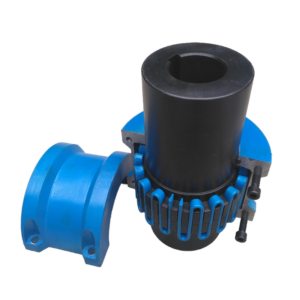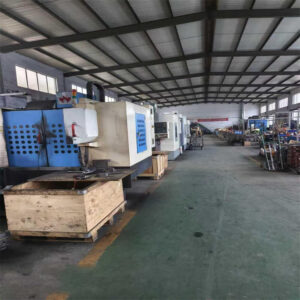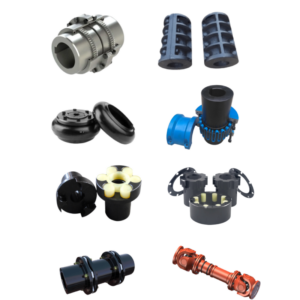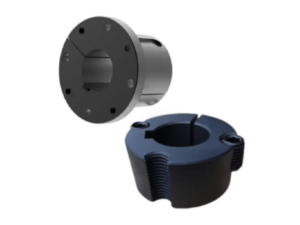1. Main Types of Spring Grid Couplings
| Type | Structure | Advantages | Disadvantages | Typical Applications |
|---|---|---|---|---|
| Standard Type | Serpentine spring strips embedded in gear slots of two coupling halves | Simple, cost-effective, easy maintenance | Limited misalignment compensation | Pumps, fans, general industrial equipment |
| Flange Type | Flange connections on both ends with bolts, sandwiching springs | High torque capacity, stable installation | Large size, requires precise alignment | Heavy machinery (compressors, marine drives) |
| Double Flange Type | Modular design with flanges on both sides and a spring grid in the middle | Handles larger misalignment, easy disassembly | Higher cost | Long-shaft systems (mining equipment) |
| Brake Disc Type | Integrated brake disc or flywheel | Space-saving, fast braking response | Customized design, limited compatibility | Cranes, elevator drives |
| High-Temperature Type | High-temperature alloy springs (e.g., Inconel) with hard-chrome-plated teeth | Withstands >400°C, oxidation-resistant | Expensive | Metallurgical equipment, kilns |
| Corrosion-Resistant Type | Stainless steel (e.g., 316L) or nickel-plated surfaces | Resists chemicals/salt spray | Slightly lower load capacity | Chemical pumps, marine systems |
| High-Flexibility Type | Optimized spring curvature for greater elasticity | Superior vibration damping, absorbs shocks | Longer axial length | Crushers, vibrating screens |
2. Key Selection Criteria
a. Load Characteristics
- High torque/impact loads: Flange or double flange types (e.g., crushers, compressors).
- Vibration-sensitive systems: High-flexibility or damped designs (e.g., generators, CNC machines).
b. Misalignment Compensation
- Large misalignment (angular/radial): Double flange or high-flexibility types (±3° angular tolerance).
- Precise alignment (<0.5mm): Standard or compact flange types.
c. Environmental Conditions
- High temperature (>200°C): High-temperature type + heat-resistant grease (e.g., molybdenum disulfide).
- Corrosive environments: Stainless steel or nickel-plated versions.
- Dust/moisture: Sealed designs (IP65 rating).
d. Space Constraints
- Compact installations: Standard or brake disc types.
- Long shaft spans: Double flange type + extended middle section.
e. Special Requirements
- Braking integration: Brake disc type (eliminates external brakes).
- Quick disassembly: Modular designs (double flange or split-type).
3. Industry-Specific Recommendations
- Mining Machinery: Double flange type (high torque, shock resistance).
- Petrochemical: Corrosion-resistant type + ATEX certification (pumps, compressors).
- Marine Systems: Flange type + stainless steel (saltwater resistance).
- Food/Pharmaceutical: Stainless steel standard type (easy cleaning, non-contaminating).
4. Common Pitfalls
- Pitfall 1: Overemphasizing flexibility, risking torque loss (excessive elasticity reduces efficiency).
- Pitfall 2: Ignoring thermal expansion (high-temperature apps require axial clearance).
- Pitfall 3: Neglecting lubrication (springs require periodic greasing to prevent wear).
5. Technical Communication Tips for Export
- Confirm certifications (e.g., CE, API 671).
- Clarify shaft bore tolerances (ANSI B17.1 vs. DIN 5480).
- Provide 3D models (STEP files) for assembly verification.







